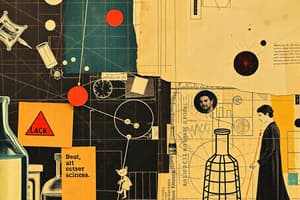Podcast
Questions and Answers
What does Bohr's model of the atom describe regarding electron behavior?
What does Bohr's model of the atom describe regarding electron behavior?
- Electrons can exist in random orbits around the nucleus.
- Electrons are stationary and do not move at all.
- Electrons can jump between specified orbitals, gaining or losing energy. (correct)
- Electrons emit radiation continuously as they revolve around the nucleus.
Which postulate is NOT part of Dalton's atomic theory?
Which postulate is NOT part of Dalton's atomic theory?
- In a compound, atoms of different elements always combine in the same way.
- Atoms of the same element are identical.
- Atoms of different elements can be identical in every respect. (correct)
- Matter is composed of small invisible particles called atoms.
What medieval practice aimed to transform metals into gold and contributed to the scientific revolution?
What medieval practice aimed to transform metals into gold and contributed to the scientific revolution?
- Alchemy and Astrology
- Astrology
- Alchemy (correct)
- Physics
According to Bohr's theory, when does an electron emit radiation?
According to Bohr's theory, when does an electron emit radiation?
Which of the following individuals is known for experimenting with dissolving metals in acid during the alchemy period?
Which of the following individuals is known for experimenting with dissolving metals in acid during the alchemy period?
What defines isotopes of the same element?
What defines isotopes of the same element?
Which part of the isotopic notation represents the number of protons?
Which part of the isotopic notation represents the number of protons?
What is the atomic mass of Carbon-12?
What is the atomic mass of Carbon-12?
Which isotope of hydrogen has two additional neutrons?
Which isotope of hydrogen has two additional neutrons?
How is the isotope notation for a neutral uranium atom with 146 neutrons expressed?
How is the isotope notation for a neutral uranium atom with 146 neutrons expressed?
How many protons does Carbon-14 contain?
How many protons does Carbon-14 contain?
What is true about the atomic mass of Carbon?
What is true about the atomic mass of Carbon?
The equation (14.0031)(X)+(15.0001)(1-X)=14.0067 is used to calculate what?
The equation (14.0031)(X)+(15.0001)(1-X)=14.0067 is used to calculate what?
Who discovered the positively charged particle in an atom?
Who discovered the positively charged particle in an atom?
What was a key observation of Rutherford's gold foil experiment?
What was a key observation of Rutherford's gold foil experiment?
Which particle was discovered by James Chadwick?
Which particle was discovered by James Chadwick?
What does the atomic number (Z) of an element represent?
What does the atomic number (Z) of an element represent?
What is the primary conflict between Rutherford's model and Maxwell's theory?
What is the primary conflict between Rutherford's model and Maxwell's theory?
Which scientist was noted for the development of the periodic table in relation to atomic number?
Which scientist was noted for the development of the periodic table in relation to atomic number?
What is a characteristic feature of an atom as described in the models discussed?
What is a characteristic feature of an atom as described in the models discussed?
What happens to the charge of an atom if it gains electrons?
What happens to the charge of an atom if it gains electrons?
Flashcards
Isotopes
Isotopes
Atoms of the same element that have the same atomic number (number of protons) but different mass numbers (number of protons and neutrons).
Isotope Notation
Isotope Notation
A notation used to represent isotopes, including the element symbol, atomic number, mass number, and charge.
Mass Number (A)
Mass Number (A)
The sum of the number of protons and neutrons in an atom's nucleus, represented by the symbol 'A'.
Atomic Number (Z)
Atomic Number (Z)
Signup and view all the flashcards
Atomic Charge (E)
Atomic Charge (E)
Signup and view all the flashcards
Atomic Mass
Atomic Mass
Signup and view all the flashcards
Isotopic Abundance
Isotopic Abundance
Signup and view all the flashcards
Isotope Separation
Isotope Separation
Signup and view all the flashcards
Quantum Concept
Quantum Concept
Signup and view all the flashcards
Bohr's Model
Bohr's Model
Signup and view all the flashcards
Quantum Leap
Quantum Leap
Signup and view all the flashcards
Law of Conservation of Mass
Law of Conservation of Mass
Signup and view all the flashcards
Law of Definite Proportion
Law of Definite Proportion
Signup and view all the flashcards
Proton
Proton
Signup and view all the flashcards
Electron
Electron
Signup and view all the flashcards
Neutron
Neutron
Signup and view all the flashcards
Thomson's Atomic Model
Thomson's Atomic Model
Signup and view all the flashcards
Rutherford's Atomic Model
Rutherford's Atomic Model
Signup and view all the flashcards
Rutherford's Gold Foil Experiment
Rutherford's Gold Foil Experiment
Signup and view all the flashcards
Ion
Ion
Signup and view all the flashcards
Study Notes
Isotopes
- Atoms of the same element with the same atomic number (Z) but different mass numbers (A)
- Identified using isotopic notation (XAZ) where:
- X = element symbol
- A = mass number (protons + neutrons)
- Z = atomic number (number of protons)
- Isotopes are distinguished by their neutron count
- Neutral atoms have equal number of protons and electrons (E=0)
- Isotope notation can also be written as element name/symbol-mass number (e.g., uranium-238 or U-238)
Isotopes and Mass Numbers
- Hydrogen has the simplest nucleus (one proton)
- Atomic mass of hydrogen is approximately 1.008 amu.
- Some hydrogen isotopes have additional neutrons:
- Deuterium (one additional neutron), atomic mass ≈ 2.014 amu
- Tritium (two additional neutrons), atomic mass ≈ 3.016 amu
- Deuterium and tritium are isotopes of hydrogen, but behave similarly chemically to normal hydrogen.
Atomic Mass and Isotopic Abundance
- Carbon has three isotopes: Carbon-12, Carbon-13, and Carbon-14
- Carbon-12 is the most common and lightest.
- Six protons
- Six electrons
- Six neutrons
- Carbon-13 is of medium weight
- Six protons
- Six electrons
- Seven neutrons
- Carbon-14 is the rarest and heaviest among the carbon isotopes.
- Six protons
- Six electrons
- Eight neutrons
Development of Atomic Structure
- Eugen Goldstein: Discovered positively charged subatomic particles (protons) in anode rays.
- Ernest Rutherford: Coined the term "proton"
- J.J. Thomson: Discovered electrons
- James Chadwick: Discovered neutrons
The Plum Pudding Model
- Thomson's model of the atom depicted electrons embedded in a sphere of positive charge, like plums in a pudding.
Rutherford's Gold Foil Experiment
- Verified Thomson's model
- Alpha particles were directed at a thin gold foil
- Most particles passed straight through
- Some particles were deflected at large angles
- A few particles bounced back
- This indicated a concentrated positive charge (nucleus) within the atom, surrounded by electrons.
Atomic Models
- Similarities and differences between Thomson and Rutherford's models: Thomson proposed a theory, compared an atom to a watermelon, and stated that electrons reside within a positively charged sphere. Rutherford conducted an experiment, stating electrons moved around a central nucleus.
- Modern atomic model: Atom is mostly empty space with a nucleus containing protons and neutrons, with electrons orbiting the nucleus.
Modern Periodic Table
- Henry Moseley: Determined the atomic number corresponds to the number of protons in an atom.
- James Maxwell: Explained that the loss of energy by moving charged particles may produce radiation and affect atom stability.
Laws of Chemistry
- Law of Conservation of Mass: Total mass of substances before a reaction equals the total mass after the reaction.
- Law of Definite Proportions: Elements combine in fixed proportions to form a compound
Studying That Suits You
Use AI to generate personalized quizzes and flashcards to suit your learning preferences.




